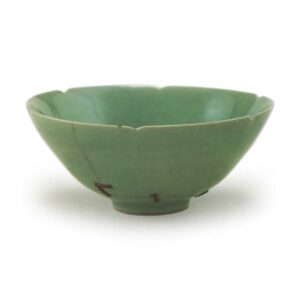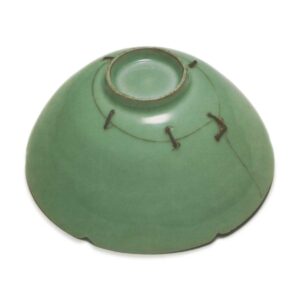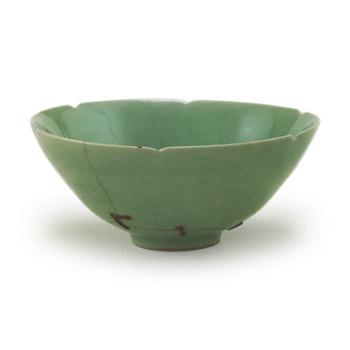

Height: 9.6cm
Diameter: 15.4cm
Height of foot ring: 4.5cm
Height of rim: 0.8cm
This is the most highly regarded of all the celadon tea bowls that have survived to the present day, and its history is also very old. According to the “Maboshi Kizuna Chasouki” (Tea Bowl with a Horsefly Knot) written by Ito Toai and accompanying the tea bowl, it is said that the tea bowl was given to Taira no Shigemori by the abbot of the time, Busshou Zenji, as a gift in return for a donation of gold to the Yugou Mountain in Song China. It was treasured in the collection of Ashikaga Yoshimasa, but because of a crack in the bottom was sent to Ming China in order to obtain a similar tea bowl, but the crack was sealed with a metal plate and the bowl was returned, and it is said that the metal plate was called “mabōkan” in China, and so the bowl came to be called “mabōkan”. Toi explains the origin of the name, saying, “The six bells tied together with iron nails are like horse-fly bands, and so I named it the ‘Horse-fly Band Tea Bowl’.”
Of the many famous tea bowls, there is only one that is said to have been passed down from the Hei Shigemori era, and although it is somewhat legendary, we cannot deny this as a mere legend.
The tea bowl was made in the 12th century, during the time of Shigemori, and the fact that trade between Japan and China was flourishing at the time means that it is impossible to deny that Shigemori owned it. However, the fact that the whereabouts of the tea bowl are unknown for around 300 years, from Shigemori to Yoshimasa, is a little weak as a tradition.
There is no doubt that it was as it has been handed down since Yoshimasa.
This celadon tea bowl has a rim that has been cut into six lobes, and is probably a product of the Longquan kiln. The glaze of the celadon is truly beautiful, as it has been handed down for many years, and the inside is slightly more blue, while the outside also has some areas that are tinged with white. There are also areas with a deep blue color, probably due to the thick build-up of glaze on the foot ring and around the foot ring.
The body is white, and the white body can also be seen on the rim under the glaze.
There is a crack around the foot ring, and a crack extends from there to the rim. This crack probably occurred because boiling water was poured into the cup. There is a small dark blue repair on the rim.
Incidentally, there is another bowl with exactly the same workmanship as this one in the collection, and it is mentioned in the “Chado Shoden-shu” as a famous tea bowl called the “Kashi-chawan”, but it is a celadon tea bowl with a large crack, and it is a tea bowl with two metal fittings on the outside.
It is said that there is a famous tea bowl called “Kashi-chawan”, but it is a celadon tea bowl with a large crack, and it is a tea bowl with two metal fittings on the outside. The metal fittings are not visible in the crack, and it is said that it was originally owned by the physician Dosan, and later owned by Oda Sanjuro, but it is not known where it is now.
It is thought that it was passed down from Masanori to Uraku Oda.
The inner box is made of plain black wood, the bag is made of yellow brocade, and the outer box is made of wood with a lacquered finish. The words “Maboshi-kan” are written on a piece of paper attached to the box.
It is recorded in the “Kansho Shushu Shoka Fu” that Yoshimasa gave this to his retainer Yoshida Soryu (died November 7, 1440, aged 76). The Yoshida family later became the Kadokura family family, and was passed down from generation to generation, including Ryo’i and Soan, but the document written by Ito Toai was recorded in the 9th year of the Kyoho era, during the reign of Genkai, the great-grandson of Sorin.
After that, it was probably passed down to the Mitsui family in Muromachi, Kyoto, from the end of the Edo period to the Meiji era, and has continued to the present day.



